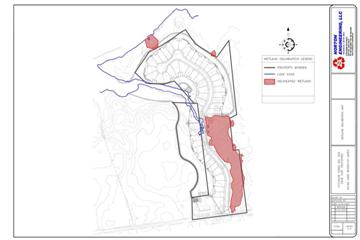Stormwater Solutions
Engineering Analysis and Advice
Solid Waste
Wastewater
Site Planning
Environmental Engineering
Structural Engineering and Building Design
Turnkey Engineering
Investigative and Legal Reports
|
Longview Cove Residential Development
A new residential subdivision is being developed on the border of Indian Lake Park in Ohio. 52 new residential lots are being subdivided on vacant land that had previously been used for farming. All lots will have water frontage on new channels connected to the existing Lake. Several environmental factors on the site required special attention and permits. Norton helped the developer to obtain these special permits:
- There is a large (4 acre) wooded wetland, and two small (less than ¼ acre) wetlands on the site.
- Part of the existing lake channel extended onto property planned to be used for residential lots.
- Historical artifacts were discovered nearby, so it was possible that they would also be present on the property;
- And migrating (endangered) "Indiana Brown Bats" were common to the area.
|

Developer's Brochure
|
Norton first conducted the wetland delineation.

Wetland Map (PDF)
The two small wetlands and the lake channel are considered federal jurisdictional waters and require a permit from the Army Corps of Engineers (a "404 Permit") in order to fill or otherwise modify any portion of them. Norton worked with the developer to ensure that the work done in these areas were in accordance with rules and restrictions of the appropriate Nationwide Permit.
The large wooded wetland is a pristine functional wetland, and Norton recommended leaving it in place and preserving it untouched. Norton worked with the site designer to detail a stormwater system for the development that would continue to send the historically delivered water into the wetland and provide for undisrupted discharge from the wetland at rates and frequencies equal to the pre-construction conditions.
Norton also guided the developer with proper methods to avoid any impacts to the wetland during construction.
Norton specified the mitigation plan for the two small wetlands.
Because of the likelihood of historic artifacts on the property and the need to get US Army Corps of Engineers Permits for the site, the developer needed to hire a certified archeologist to conduct a Phase I study for artifacts on the property. The US Army Corps of Engineers cannot issue a permit without having complete assurance that there are no historical artifacts on the project site. The archaeologist determined that there was nothing of significance to prevent development on the property.
Because of the likelihood of impacting any Endangered Species (in this case migrating "Indiana Brown Bats") by modifying migratory bat housing that might be on the property and the need to get US Army Corps of Engineers Permits for the site, the developer needed to do a survey of any potential impacts to these endangered species.
All of the fore-mentioned sensitive environmental issues were considered in the development of this first class residential neighborhood. The wooded wetland will be selling point for buyers looking for a nice house on a lake with a backwoods setting.
|
|
| |



